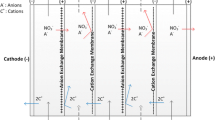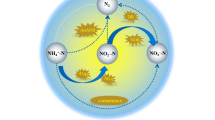Abstract
In this study a completely stirred tank reactor was used to study the effect of sulfide to nitrate (S/N) ratio on sulfide removal while nitrate was used as electron acceptor. Several S/N ratios were studied for this purpose ranging from 0.3 to 2.4 mol/mol. The complete sulfide removal was achieved when S/N ratio 0.85 mol/mol was used with the autotrophic denitrification efficiency up to 80 %. No nitrite accumulation was observed, and the main product of sulfide oxidation was sulfate. Dissimilatory nitrogen reduction to ammonia occurred and subsequently, elemental sulfur accumulated while S/N ratio was higher than 1.3 mol/mol. The specific autotrophic denitrification rates under S/N ratios 0.8 and 1.2 were 5 and 26 mg g−1 h−1 (N-NO3 −, VSS), respectively. Thiobacillus denitrificans and Thiomicrospira denitrificans were detected in the reactor by fluorescent in situ hybridization, but their overall representation was not more than 5 % of the entire microbial populations.








Similar content being viewed by others
References
Alcántara S, Velasco A, Muñoz A, Cid J, Revah S, Razo-Flores E (2003) Hydrogen sulfide oxidation by a microbial consortium in a recirculation reactor system: sulfur formation under oxygen limitation and removal of phenols. Environ Sci Technol 38:918–923. doi:10.1021/es034527y
Amann R (1995) In situ identification of micro-organisms by whole cell hybridization with rRNA-targeted nucleic acid probes. In: Elsas J, Bruijn F, Akkermans AL (eds) Molecular microbial ecology manual. Springer, The Netherlands, pp 331–345. doi:10.1007/978-94-011-0351-0_23
Amann RI, Binder BJ, Olson RJ, Chisholm SW, Devereux R, Stahl DA (1990) Combination of 16S rRNA-targeted oligonucleotide probes with flow cytometry for analyzing mixed microbial populations. Appl Environ Microbiol 56:1919–1925
American Public Health Association AWWAWEF (2005) Standard methods for the examination of water & wastewater. American Public Health Association, Washington, D.C
Brunet RC, GarciaGil LJ (1996) Sulfide-induced dissimilatory nitrate reduction to ammonia in anaerobic freshwater sediments. Fems Microbiol Ecol 21:131–138
Campos JL, Carvalho S, Portela R, Mosquera-Corral A, Méndez R (2008) Kinetics of denitrification using sulphur compounds: effects of S/N ratio, endogenous and exogenous compounds. Bioresour Technol 99:1293–1299
Cardoso RB, Sierra-Alvarez R, Rowlette P, Flores ER, Gómez J, Field JA (2006) Sulfide oxidation under chemolithoautotrophic denitrifying conditions. Biotechnol Bioeng 95:1148–1157. doi:10.1002/bit.21084
Claus G, Kutzner H (1985) Physiology and kinetics of autotrophic denitrification by Thiobacillus denitrificans. Appl Microbiol Biotechnol 22:283–288. doi:10.1007/BF00252031
Daims H, Brühl A, Amann R, Schleifer KH, Wagner M (1999) The domain-specific probe EUB338 is insufficient for the detection of all bacteria: development and evaluation of a more comprehensive probe set. Syst Appl Microbiol 22:434–444
Daims H, Lücker S, Wagner M (2006) Daime, a novel image analysis program for microbial ecology and biofilm research. Environ Microbiol 8:200–213. doi:10.1111/j.1462-2920.2005.00880.x
Fajardo C, Mosquera-Corral A, Campos JL, Méndez R (2012) Autotrophic denitrification with sulphide in a sequencing batch reactor. J Environ Manage. doi:10.1016/j.jenvman.2012.03.018
Fajardo C, Mora M, Fernández I, Mosquera-Corral A, Campos JL, Méndez R (2014) Cross effect of temperature, pH and free ammonia on autotrophic denitrification process with sulphide as electron donor. Chemosphere 97:10–15. doi:10.1016/j.chemosphere.2013.10.028
Fernández N, Gómez R, Amils R, Sierra-Alvarez R, Field JA, Sanz JL (2006) Microbiological and structural aspects of granular sludge from autotrophic denitrifying reactors. Water Sci Technol 54:11–17
Horáková M (2003) Analytika vody. VŠCHT, Praha
Jenkins D, Richard MG, Daigger GT (2004) Manual on the causes and control of activated sludge bulking, foaming and other solids separation problems, 3rd edn. Lewis, London
Kleerebezem R, Mendez R (2002) Autotrophic denitrification for combined hydrogen sulfide removal from biogas and post-denitrification. Water Sci Technol 45:349–356
Lee KC, Bowerbank G, Van Heeringen G THIOPAQ OG (2013) Bio-desulphurisation; an alternative sulphur recovery technology. In: GPA Annual Convention Proceedings. pp 219–228
Lens PNL, Pol LWH (2000) Environmental technologies to treat sulfur pollution: principles and engineering. IWA Publishing, UK
Lohwacharin J, Annachhatre AP (2010) Biological sulfide oxidation in an airlift bioreactor. Bioresour Technol 101:2114–2120. doi:10.1016/j.biortech.2009.10.093
Manconi I, Carucci A, Lens P (2007) Combined removal of sulfur compounds and nitrate by autotrophic denitrification in bioaugmented activated sludge system. Biotechnol Bioeng 98:551–560. doi:10.1002/bit.21383
Manz W, Amann R, Ludwig W, Wagner M, Schleifer KH (1992) Phylogenetic oligodeoxynucleotide probes for the major subclasses of proteobacteria: problems and solutions. Syst Appl Microbiol 15:593–600
Mobarry BK, Wagner M, Urbain V, Rittmann BE, Stahl DA (1996) Phylogenetic probes for analyzing abundance and spatial organization of nitrifying bacteria. Appl Environ Microbiol 62:2156–2162
Moon HS, Ahn K-H, Lee S, Nam K, Kim JY (2004) Use of autotrophic sulphur-oxidizers to remove nitrate from bank filtrate in a permeable reactive barrier system. Environ Pollut 129:499–507
Mora M, Guisasola A, Gamisans X, Gabriel D (2014) Examining thiosulfate-driven autotrophic denitrification through respirometry. Chemosphere 113:1–8. doi:10.1016/j.chemosphere.2014.03.083
Moraes BS, Foresti E (2012) Determination of the intrinsic kinetic parameters of sulfide-oxidizing autotrophic denitrification in differential reactors containing immobilized biomass. Bioresour Technol 104:250–256
Moraes BS, Souza TSO, Foresti E (2012) Effect of sulfide concentration on autotrophic denitrification from nitrate and nitrite in vertical fixed-bed reactors. Process Biochem 47:1395–1401
Oh SE, Bum MS, Yoo YB, Zubair A, Kim IS (2003) Nitrate removal by simultaneous sulfur utilizing autotrophic and heterotrophic denitrification under different organics and alkalinity conditions: batch experiments. Water Sci Technol 47:237–244
Oh SE, Kim CH, Choi CK (2010) Kinetics and physiological characteristics of autotrophic denitrification by denitrifying sulphur bacteria. Water Sci Technol 42:59–68
Ongcharit C, Sublette KL, Shah YT (1991) Oxidation of hydrogen sulfide by flocculated Thiobaccillus denitrificans in a continuous culture. Biotechnol Bioeng 37:497–504. doi:10.1002/bit.260370602
Reyes-Avila J, Razo-Flores EA, Gomez J (2004) Simultaneous biological removal of nitrogen, carbon and sulfur by denitrification. Water Res 38:3313–3321. doi:10.1016/j.watres.2004.04.035
Shao MF, Zhang T, Fang HHP (2010) Sulfur-driven autotrophic denitrification: diversity, biochemistry, and engineering applications. Appl Microbiol Biotechnol 88:1027–1042
Sikora LJ, Keeney DR (1976) Evaluation of a sulfur Thiobacillus denitrificans nitrate removal system. J Environ Qual 5:298–303
Tang K, An S, Nemati M (2010) Evaluation of autotrophic and heterotrophic processes in biofilm reactors used for removal of sulphide, nitrate and COD. Bioresour Technol 101:8109–8118
Vaiopoulou E, Melidis P, Aivasidis A (2005) Sulfide removal in wastewater from petrochemical industries by autotrophic denitrification. Water Res 39:4101–4109. doi:10.1016/j.watres.2005.07.022
van der Zee FP, Villaverde S, García PA, Fdz-Polanco F (2007) Sulfide removal by moderate oxygenation of anaerobic sludge environments. Bioresour Technol 98:518–524. doi:10.1016/j.biortech.2006.02.011
Wang J, Lu H, Chen G-H, Lau GN, Tsang WL, van Loosdrecht MCM (2009) A novel sulfate reduction, autotrophic denitrification, nitrification integrated (SANI) process for saline wastewater treatment. Water Res 43:2363–2372. doi:10.1016/j.watres.2009.02.037
Wong B-T, Lee D-J (2011) Denitrifying sulfide removal and carbon methanogenesis in a mesophilic, methanogenic culture. Bioresour Technol 102:6673–6679. doi:10.1016/j.biortech.2011.03.097
Yamamoto-Ikemoto R, Komori T, Nomuri M, Ide Y, Matsukami T (2000) Nitrogen removal from hydroponic culture wastewater by autotrophic denitrification using thiosulfate. Water Sci Technol 42:369–376
Acknowledgments
This research was financed by grant no. TA01020798 “Komplexní biotechnologie pro spojené odstraňování sulfanu z bioplynu a nutrientů z odpadních vod na čistírnách odpadních vod, bioplynových stanicích a podobných technologických celcích” and grant no. MSM6046137308 “Studium chemických a biologických procesů pro ochranu životního prostředí.”
Conflict of interest
The authors have declared no conflict of interest.
Author information
Authors and Affiliations
Corresponding author
Rights and permissions
About this article
Cite this article
Dolejs, P., Paclík, L., Maca, J. et al. Effect of S/N ratio on sulfide removal by autotrophic denitrification. Appl Microbiol Biotechnol 99, 2383–2392 (2015). https://doi.org/10.1007/s00253-014-6140-6
Received:
Revised:
Accepted:
Published:
Issue Date:
DOI: https://doi.org/10.1007/s00253-014-6140-6




